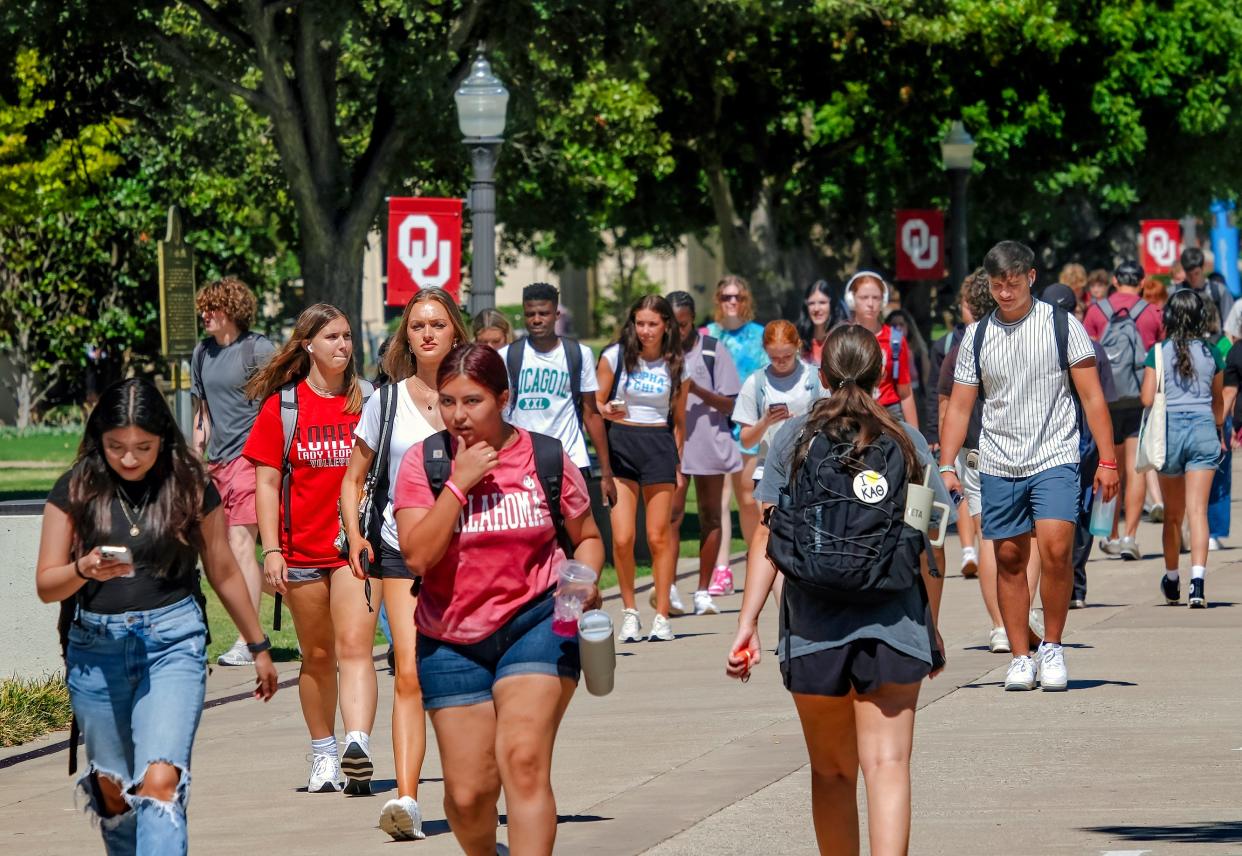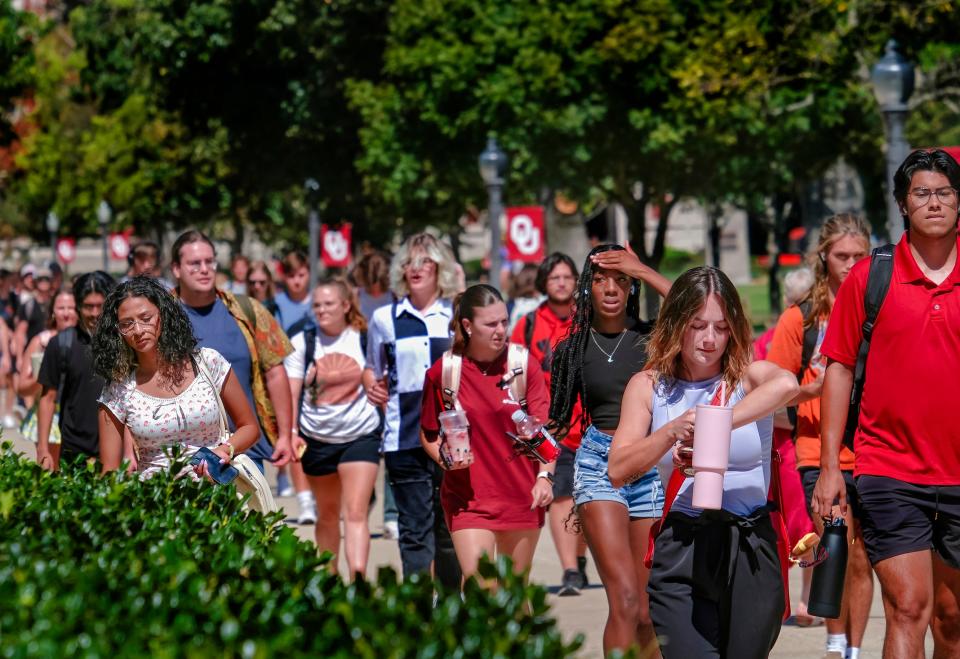Oklahoma governor signs order defunding DEI efforts in public colleges: What we know

- Oops!Something went wrong.Please try again later.
In issuing an executive order that he hopes will eliminate diversity, equity and inclusion (DEI) programs on Oklahoma college campuses, Gov. Kevin Stitt said the move amounts to “taking politics out of education.”
To University of Oklahoma sophomore Liam Thompson, of Norman, what Stitt did will have exactly the opposite effect.
“They talk about how DEI shouldn’t be a political thing,” Thompson said Thursday, as OU students were in the midst of their finals week. “But signing this order really makes it a political issue.”
On Wednesday, Stitt accomplished a goal of Oklahoma conservatives with his order requiring state agencies and institutions of higher education in Oklahoma to initiate a review of DEI positions, departments, activities, procedures and programs to “eliminate and dismiss” what the order called “non-critical personnel.”
But others, from national and local experts on diversity to current college students like Thompson, say the removal of DEI offices and programs from Oklahoma colleges likely will have a profound impact on the level of services that can be offered to students from nontraditional backgrounds.
“Using an executive order to return to an era when higher education failed to address the needs of all students is shortsighted and outrageous,” said Paulette Granberry Russell, the president and chief executive officer of the National Association of Diversity Officers in Higher Education.
“With these political actions, elected leaders, including Governor Stitt, are making a calculated attempt at the state level to discredit and diminish effective, proven mechanisms that have opened doors of opportunity and helped historically marginalized students earn their degrees. These actions rebuild barriers for groups that were historically marginalized and pushed aside. They do nothing to support students,” Granberry Russell said.
Oklahoma's DEI scrutiny reflects national trends
With Stitt’s action, Oklahoma joined Florida and Texas as states that have banned DEI programs in state higher-education institutions. Like Oklahoma, both Florida (Ron DeSantis) and Texas (Greg Abbott) have Republican governors and Republican-dominated legislatures.
In concert with Stitt’s order, state Sen. Rob Standridge, R-Norman, has introduced four bills for consideration during the upcoming session of the Oklahoma Legislature that would prohibit the establishment of a DEI office or hiring or assigning of employees at Oklahoma higher education institutions to carry out DEI practices.
More: Oklahoma governor executive order to put higher education diversity programs under review
Conservatives target financial impact of DEI programs
Politically and culturally, DEI has a larger footprint than it does on the financial books of Oklahoma institutions. State higher education Chancellor Allison Garrett told members of the state Senate’s Education Committee on Thursday only 11 of Oklahoma’s 25 colleges and universities have a person listed on their payroll as a diversity officer. Garrett also said spending on DEI programs amounted to about 0.1% of state funds for higher education in Oklahoma.
Still, the programs have become a target for conservatives. Before Stitt’s press conference on Wednesday, an anonymous man went through the Blue Room at the state Capitol ― where the event was held — and handed out cards with the headlines, “Stop Feeding The Beast” and “OU’s Commitment to DEI (DIE).” Included on the card was a QR link to a website listing links to stories — the majority of which were produced by the Oklahoma Council of Public Affairs, a conservative think tank — about what it said were various DEI expenditures at OU.
One of the items listed on the card that was handed out claimed that “OU spent $1 million furnishing menstrual products in Men’s bathrooms” and cited the OCPA as a source.
Another OU student, senior Robby Frost, of Plano, Texas, said he hadn’t noticed any menstrual products in the men’s bathroom, but even if that story is true, “I don’t think it’s a bad thing. In some cases, that’s needed when the school is doing that. They’re giving people in those groups an equal chance. That doesn’t hurt me.” Frost said while it might make some “traditional, conservative” people uncomfortable, for other groups, “it makes them feel better and like maybe they do belong here.”
OU, OSU students and faculty react
Stitt is casting the order as “defunding discrimination.” OU senior Tamera Nealy, of Oklahoma City, joined Stitt in speaking during Wednesday’s ceremony and said the executive order was important “because it challenges students from all around Oklahoma and the country to not only try, but do your best, and we have to raise the standard, we have to raise the bar.”
Others say instead of raising the bar, the order will only serve to make college campuses less diverse and inclusionary. The Black Emergency Response Team, a student group at OU that organized against racist incidents, said in a statement to the OU Daily the DEI programs “give students a voice to be heard, provide a home away from home, and create unity within the student life community on campus. To remove personnel, funding, and programming, is to jeopardize the existence of these spaces altogether."
The statement said, "Stitt is aggressively targeting students from all marginalized communities with blatant discrimination, hiding behind the deceptive narrative that merit-based success and hard work are all that’s needed for advancement.”

OU President Joseph Harroz issued a strongly worded letter to students on Wednesday and Oklahoma State University President Kayse Shrum did the same on Thursday.
“OSU faculty, staff and students are guided by the Cowboy Code,” Shrum said, “which invigorates us with a ‘passion to do what’s right,’ and united in the Cowboy Culture, which demands that ‘we treat every individual with dignity and respect and recognize that differences can serve to strengthen and enrich the fabric of life.’ Those fundamental commitments will not change. We are committed to supporting our students, faculty and staff and want everyone to know they are a valued member of the Cowboy family.” The word “everyone” was in boldface type.
Thompson, the OU student, noted that such items as compliance with the Americans With Disabilities Act (ADA) typically go through the DEI office “to ensure equitable access for people with disabilities to the campus as well. … Does the governor know anybody who’s disabled?”
Students from tribal nations voice concerns about 'more barriers'
DEI offices also handle issues regarding students from Oklahoma’s 39 federally recognized tribal nations. Cherokee Nation Principal Chief Chuck Hoskin, long an adversary of Stitt, said the order is another attempt by the governor to create “more barriers for diverse student populations, including Native American students enrolled throughout our state colleges and universities. … The governor is signaling that these voices and offices in places for outreach don’t matter.”
Granberry also mentioned Oklahoma’s high number of tribal nations in questioning Stitt’s order.
“One would think that in a state that is home to almost 40 American Indian federally recognized nations, Oklahoma would be actively and enthusiastically welcoming such a proud cultural aspect of its population rather than pushing it away,” Granberry said.
What will happen to the OU and OSU DEI offices? Although both have said they would comply with Stitt’s order, neither university wanted to comment on Thursday on what exactly that might look like. But the leaders of both campuses hope they’ve cultivated a climate of inclusion on their campuses that will continue. Short, the student, said he believes it will at OU.
“It comes down to whenever we have people who fall into underserved groups, we want to make sure they’re welcome and heard,” Short said. “It’s that simple.”
This article originally appeared on Oklahoman: Oklahoma governor orders DEI defunded: What we know

